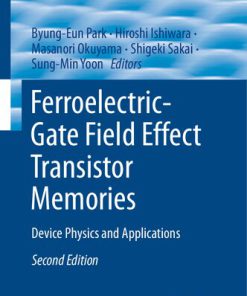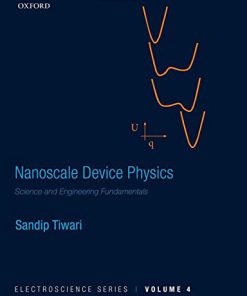Compound Semiconductors Physics Technology and Device Concepts 1st Edition by Ferdinand Scholz 9781315229317 1351858718
$50.00 Original price was: $50.00.$25.00Current price is: $25.00.
Compound Semiconductors Physics Technology and Device Concepts 1st Edition by Ferdinand Scholz – Ebook PDF Instant Download/Delivery:9781315229317,1351858718
Full download Compound Semiconductors Physics Technology and Device Concepts 1st Edition after payment
![]()
Product details:
ISBN 10:1351858718
ISBN 13:9781315229317
Author:Ferdinand Scholz
This book provides an overview of compound semiconductor materials and their technology. After presenting a theoretical background, it describes the relevant material preparation technologies for bulk and thin-layer epitaxial growth. It then briefly discusses the electrical, optical, and structural properties of semiconductors, complemented by a description of the most popular characterization tools, before more complex hetero- and low-dimensional structures are discussed. A special chapter is devoted to GaN and related materials, owing to their huge importance in modern optoelectronic and electronic devices, on the one hand, and their particular properties compared to other compound semiconductors, on the other. In the last part of the book, the physics and functionality of optoelectronic and electronic device structures (LEDs, laser diodes, solar cells, field-effect and heterojunction bipolar transistors) are discussed on the basis of the specific properties of compound semiconductors presented in the preceding chapters of the book. Compound semiconductors form the back-bone of all opto-electronic and electronic devices besides the classical Si electronics. Currently the most important field is solid state lighting with highly efficient LEDs emitting visible light. Also laser diodes of all wavelength ranges between mid-infrared and near ultraviolet have been the enabler for a huge number of unprecedented applications like CDs and DVDs for entertainment and data storage, not to speak about the internet, which would be impossible without optical data communications with infrared laser diodes as key elements. This book provides a concise overview over this class of materials, including the most important technological aspects for their fabrication and characterisation, also covering the most relevant devices based on compound semiconductors. It presents therefore an excellent introduction into this subject not only for students, but also for engineers and scientist who intend to put their focus on this field of science.
Compound Semiconductors Physics Technology and Device Concepts 1st Table of contents:
1. Basics
1.1 What Is a Semiconductor?
1.2 Naive Band Diagram
1.3 Crystal Lattice: Basics
1.3.1 Crystal Planes, Miller Indices
1.3.2 Reciprocal Lattice
1.4 More Details about Band Structure
1.4.1 Insert: Very Short Introduction to Quantum Mechanics
1.4.2 Schrödinger Equation and Dispersion Relation
1.4.3 Short Summary Up to Now
1.5 Effective Mass
1.6 Movement of Carriers: Concept of Hole
1.7 Real Band Structures
1.8 Temperature Dependence of Lattice Constant and Band Gap
1.9 Interaction with Light
1.10 Carrier Statistics
1.10.1 Density of States
1.10.2 Fermi Distribution
1.11 Defects in Semiconductors
2. Introduction to Compound Semiconductors
3. Bulk Crystal Growth
3.1 Czochralski Method
3.2 Bridgman Crystal Growth
3.3 Wafer Preparation
4. Epitaxial Methods
4.1 Liquid Phase Epitaxy (LPE)
4.1.1 Control of Growth Rate and Layer Thickness
4.1.2 LPE Equipment
4.2 Vapor Phase Epitaxy (VPE)
4.3 Metalorganic Vapor Phase Epitaxy
4.4 Molecular Beam Epitaxy
4.4.1 Equipment Details
4.5 Comparison of Epitaxial Methods
5. Electrical Properties of Semiconductors/Electrical Characterization
5.1 Carrier Concentration and Doping
5.2 Carrier Mobility
5.3 Measurement of Electrical Properties
5.3.1 HallEffect
5.3.2 C–V Profiling
5.4 Secondary Ion Mass Spectrometry
6. Optical Processes in Semiconductors: Optical Spectroscopy
6.1 Basic Optical Processes
6.2 Steady-State Excitation
6.3 Optical Characterization Methods
6.3.1 Photoluminescence
6.3.2 Absorption
6.3.3 Lateral Absorption and Gain Spectroscopy
6.3.4 Fourier Spectroscopy
6.3.5 Other Related Methods
6.4 Some Technical Details
7. X-Ray Diffraction
7.1 Basics
7.2 What Can Be Measured?
7.3 Diffractometer Equipment
8. Quantum Wells
8.1 Semiconductor Heterojunction
8.2 Quantum Well: Eigenstates
8.3 Density of States
8.4 Behavior at k→ = 0
8.5 High Carrier Mobility in a Quantum Well
8.6 Coupling of Several Quantum Wells: Resonant Tunneling
9. Strain
9.1 Elastic Deformation of a Solid
9.2 Influence on Electronic Band Structure
9.3 Critical Thickness
9.4 Usefulness of Strain
10. Low-Dimensional Systems
10.1 Band Structure, etc
10.2 Fabrication of Low-Dimensional Structures
10.3 Properties of Self-Assembled Dots
11. Group III Nitrides
11.1 Basic Properties
11.2 Bulk Material, Substrates
11.3 Hetero-Epitaxy, Defect Reduction
11.4 Doping of GaN
11.5 Ternary Alloys
11.6 Polarization and Piezoelectricity
11.7 Diluted Nitrides
12. Optoelectronic Devices
12.1 Light-Emitting Diode
12.1.1 Optical Transitions
12.1.2 Internal and External Efficiencies
12.1.3 Luminous Efficacy
12.1.4 LED Colors, White LEDs
12.1.5 LED Efficiencies
12.2 Semiconductor Laser Diodes
12.2.1 Gain
12.2.2 Resonator and Feedback
12.2.3 Electrical Pumping
12.2.4 Optical Waveguide and Confinement
12.2.5 Temperature Behavior
12.2.6 Lateral Confinement
12.2.7 Near Field, Far Field
12.2.8 Distributed Feedback Lasers
12.2.9 Vertical-Cavity Surface-Emitting Laser
12.3 Solar Cells
12.3.1 Basic Working Principle
12.3.2 Solar Spectrum
12.3.3 Compound Semiconductors and Photovoltaics
12.3.4 Multi-Junction Solar Cell
12.3.5 Concentrator Cells
12.3.6 PV Systems with Highest Efficiency
13. Electronic Devices
13.1 Field-Effect Transistor
13.2 Heterobipolar Transistor
People also search for Compound Semiconductors Physics Technology and Device Concepts 1st :
institute for compound semiconductors
compound semiconductor example
what are compound semiconductors used for
international symposium on compound semiconductors
compound semiconductors are also known as
Tags:
Ferdinand Scholz,Semiconductors,Technology,Concepts
You may also like…
Cookbooks
Engineering
Ferroelectric Gate Field Effect Transistor Memories Device Physics and Applications Byung-Eun Park
Engineering
III V Compound Semiconductors and Devices An Introduction to Fundamentals Keh Yung Cheng
Physics - Solid State Physics
Physics
Nanoscale Device Physics Science and Engineering Fundamentals 1st by Tiwari 9780198759874 0191078042








